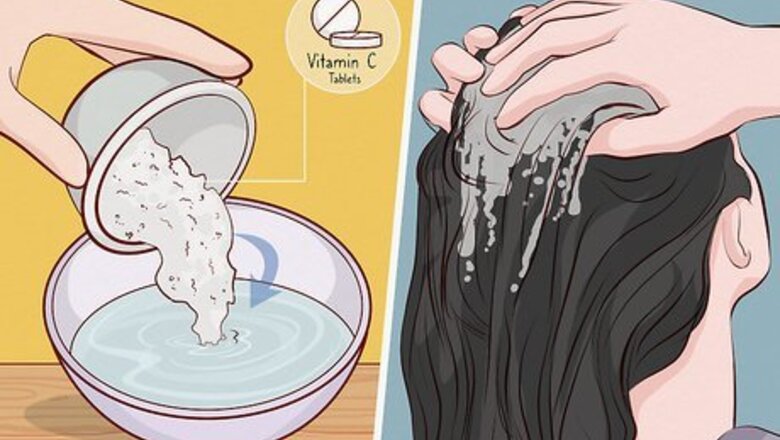
views
Try Home Remedies
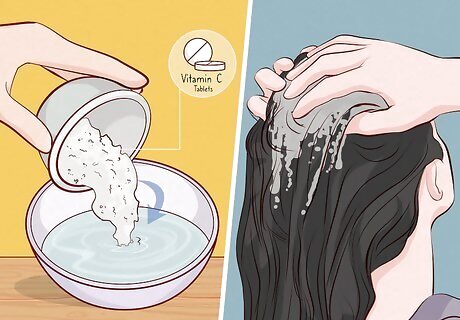
Use a Vitamin C treatment. Much like removing other hair colors from your hair, a Vitamin C treatment could lighten your black hair a shade or 2. However, this works best with semi-permanent color as the acid will work more like lemon juice to lighten your hair. Make a paste of Vitamin C tablets and water. Apply the paste to damp hair Let it set for about an hour Wash the paste out of your hair
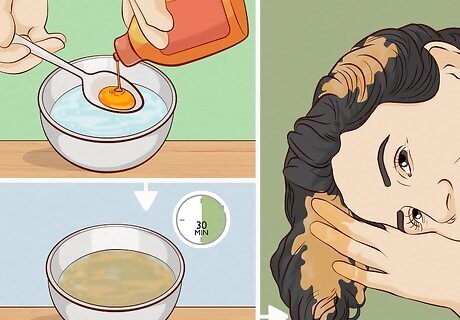
Try a raw honey treatment. Raw honey may not strip the hair color as much as it might turn it a lighter shade. The treatment is known to produce peroxide and we know this as a form of bleach. You will need to use raw, unpasteurized honey, which you should be able to get at a farmer’s market or direct from a local honey producer. Mix 4 parts raw honey with 1 part water. Let the mixture sit for 30 minutes to an hour. Apply the mixture to damp hair. Cover your hair and let it sit for at least for 2 hours. Rinse and repeat as desired. You can do this a few times every week to gradually lighten your hair color.
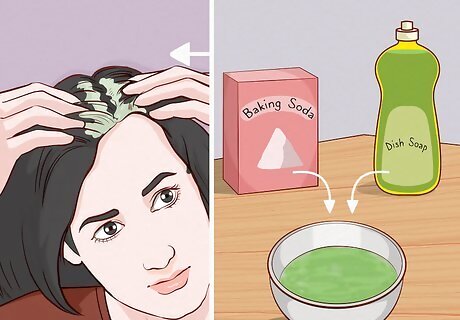
Use dish soap with baking soda. This treatment will be harsher on your hair than shampoo, so you'll need to follow it with a deep conditioner. If you're prone to dryness and breakage, it may be safer to avoid this altogether. Mix 5 drops of dish soap with a quarter sized amount of shampoo. Massage the mixture into damp hair. Let it sit for a few minutes. Rinse and repeat as desired.
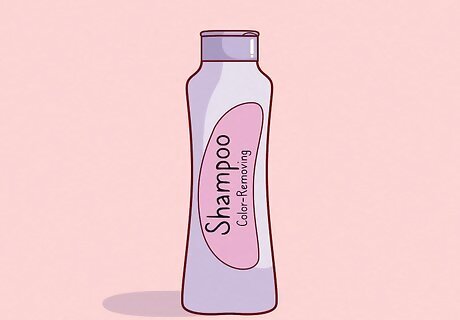
Use a clarifying shampoo. Using a clarifying shampoo is by far the easiest way to lighten your hair. It will act faster than normal washing. Clarifying shampoos designed to get chlorine out of hair help with removal of black hair color. Anti-dandruff shampoos have also been known to strip some types of hair color from your hair. This effect can be enhanced in some cases by mixing with equal parts baking soda. Keep it on your hair for a few minutes and then rinse to check the results. This may require multiple washes to get the desired results. Washing your hair multiple times will see more hair color go down the drain each time. However, do not do this more than 3 times in a day.

Try an oil treatment. This is recommended to remove henna, indigo, and other stain hair colors, but it will not work for permanent hair colors. It may not remove the color any faster than washing does. Choose a lightweight oil (like Argan or jojoba oils) or purchase a hair-specific oil. You may be able to make your own mixture or purchase something premixed. You also may want to purchase enough to do the treatment twice. Apply an ample amount to your entire head. Let it sit for as long for a few hours. If you can, cover your hair and keep the oil on overnight, it could give you better results. Remove the oil with shampoo. Remember, oil and water don’t mix well so you may need to wash it a few times to get the oil out. This method reduces the chances for damage as the oil should be conditioning your hair while it strips the color.
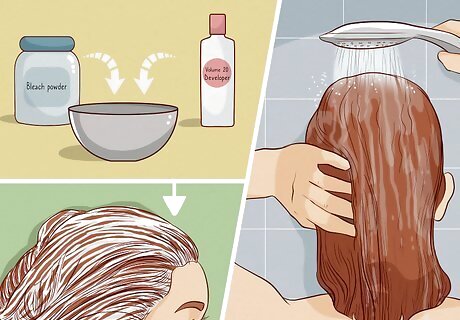
Do a bleach wash. A bleach wash is a gentler way to bleach your hair that involves mixing bleach with shampoo. The shampoo dilutes the bleach (meaning less chance of damage) and helps it spread evenly throughout your hair so you don't end up with streaks. Depending on how much lighter you want to take your hair, you may need to do multiple bleach washes. Start with unwashed hair. The natural oils will protect your scalp from irritation. Mix bleach powder with volume 20 developer per the instructions on the packet. Add an equal amount of shampoo to the bleach mixture. Wet your hair so it's damp and lather the bleach-shampoo mixture into your hair with your hands or a dye brush (but don't apply the mixture to your roots yet!). Stop applying the mixture about 1 inch (2.5 cm) away from your roots. They will develop faster and turn out much lighter if you bleach them at the same time as the rest of your hair. Once you've saturated the middle and ends of your hair, wait about 10-15 minutes before applying the bleach-shampoo mixture to your roots. When your roots have lightened with the rest of your hair, rinse your hair.
Using Color-Removing Kits
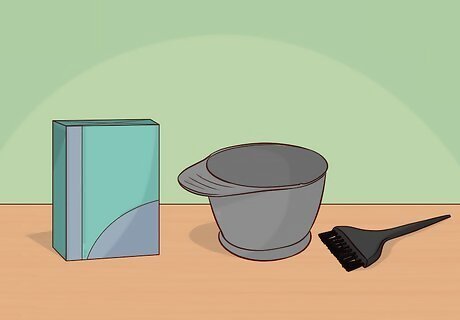
Purchase a color removing kit. Hair color removal kits are designed for the removal of any unwanted permanent hair color. There are a variety of these kits on the market, each of which contain different chemicals and instructions. Keep in mind that these kits will not work on semi-permanent box colors, since these may contain metallic salts and other natural coloring agents that the hair removal kit will not have an effect on. Look for extra strength as black hair color is the most difficult color to remove. Consider your length and how heavy the color is that you used. Think about getting two boxes in case you need a double treatment. Two boxes can also come in handy if you have long or thick hair. You can find a hair color removal kit at beauty supply stores and drug stores. Most professional hair care experts recommend against using an at-home color removing kit—they need to be applied meticulously yet quickly, and they can lead to hair breakage. If you're concerned about the integrity of your hair, it's best to see a professional colorist.
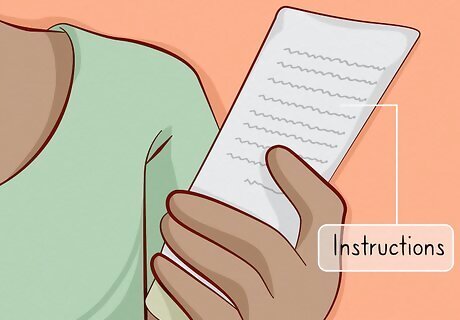
Read the instructions. Be sure to carefully read the manual contained in the kit, and follow all steps as indicated for the best results. Check for any possible side effects like a color change or intense drying that you may need to prepare a conditioner to treat. Throwing another color on top of the black, like brown, won't turn your hair brown because the black has already penetrated into the hair follicles.
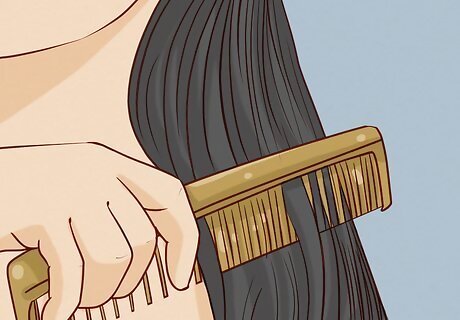
Prepare before starting to apply. Similar to coloring your hair you will need to put on specific cloths, use gloves and prepare your hair before you start putting the chemicals on your hair. You may want to add a towel around your shoulders in case the chemical is watery and drips. Put on clothes you are ok with staining, such as an old t-shirt. If you're using a towel around your shoulders, use a dark-colored one. Brush your hair before application. Otherwise, the chemicals could get caught in the tangles of your hair, which could result in an uneven application. Use a balm like vaseline to cover your face and around your hairline to avoid any staining or skin interactions. This will keep the skin from having too much chemicals on it. This is also a great option to remember the next time you color your hair to keep your skin from changing colors. Put on your gloves and start mixing. Now that you are prepared for working with the chemical read the instructions and mix it before putting it on your head. Some kits will have a very sulfur or rotten egg smell that could be distracting. It may be best to turn on a bathroom fan.
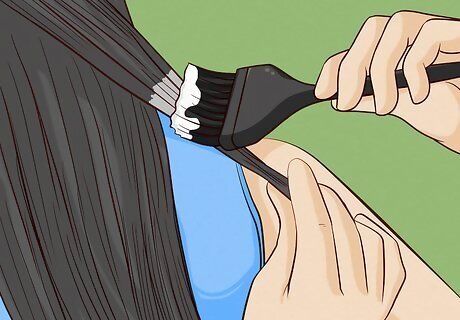
Do a strand test. It is also a good idea to do a strand test before you apply the product to all of your hair. Choose a strand of hair that will be hidden if you do not like the results and apply the product to that section first. Then, go through the process with the strand to see if it works the way you want it to. If it does, then continue applying the product to all of your hair. Choose a section of hair that is hidden under the rest of your hair, such as in the back of your head. Depending on the hair color you have, the color will be removed but in very specific ways. You won't go from a black to a blonde, but you might go from a black to a chestnut or red brown.
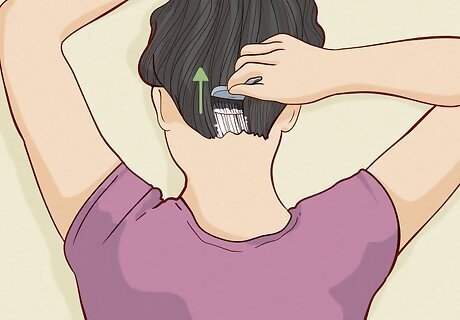
Apply to your hair. Now that the chemical is ready it is best to apply to your hair evenly. Some of the color-removing kits have a more watery consistency than others. Apply in 1 inch (2.5 cm) sections starting from the bottom half of your hair and moving up to the crown. This will give you consistency throughout the hair. It will allow you to control how much product gets on your hair as well. Cover and wait for the allotted amount of time. If your product works best with heat look at placing a blow dryer on a heat resistant stand pointed down at your head while you sit on the floor.
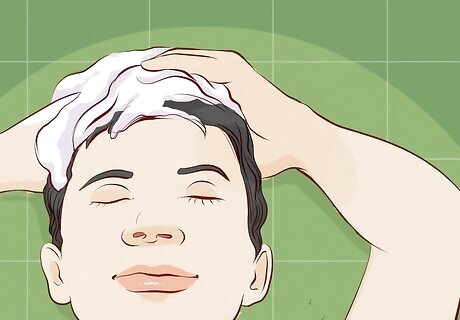
Rinse and shampoo your hair after you have finished removing the color. Make sure to get all of the color removal product and residue out of your hair by rinsing it thoroughly and then shampooing your hair as you normally would. Follow your color removal kit’s rinsing and shampooing instructions carefully. Some kits come with a special shampoo to use after you finish removing the black hair color. You may need to rub the shampoo into your hair a certain way to get all of the product and hair color residue out. Do not rub the shampoo into your scalp! You may also need to apply a post-shampoo developer to your hair with some kits. Check to see if this is included with your kit, and do not skip it if it is part of the process.
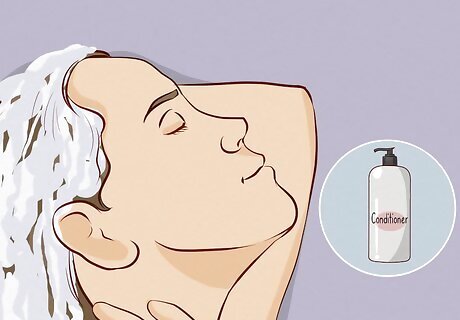
Do a deep conditioning treatment. This is best to have prepared just in case you need it for brittle or damaged hair. Add a hair mask or consider not doing styles that require excessive heat or blow drying for best results.
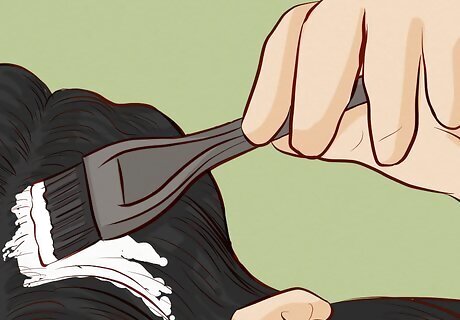
Color it again. When using an at-home hair color removal kit, be aware that you may have to color your hair following the removal of the black hair color. This is due to the fact that your hair will likely be lighter in color than its natural shade following the removal of the black hair color. While this may be acceptable for some, you may prefer to add additional color to get a more natural look. You may also want to wait to color your hair again for at least a couple of weeks to give time to rest. However, many kits will say your hair is safe to color after bout 24 hours. Spot test the color on your skin to make sure it doesn't cause any irritation.
Seeking Professional Help
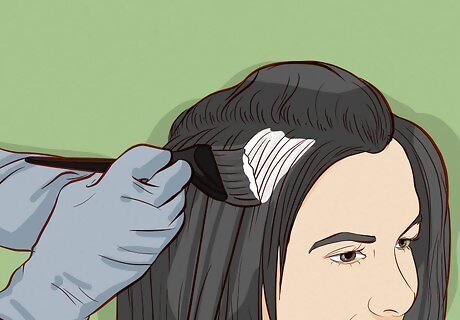
Expect the process to take a few sessions. It can be a long process to lighten your hair closer to your normal color after you've applied black hair color. Think about what you will be getting into with this process and where you hope to be by the end. Each session may include a stylist bleaching out the color and toning it to an acceptable shade. A professional hair stylist may lighten your hair with lighteners and professional strength hair color removers. It could be several sessions but the professionals will know how to reduce damage and the proper products to send you home with to continue the process. There may still be a stage where your hair is orange. However, this is temporary, and your final hair color will usually be applied after this stage. Discuss different options with a trusted stylist.

Get a quote. Removing black hair color is an expensive process. It is best to shop around at a few different salons to find a group with a good price that you can trust. Finding stylist you trust and feel comfortable having work on your hair is just as important as the price, so it is okay to go to multiple consultations. Realize that you will get what you pay for so going for the cheapest quote could cost you your lovely hair just as much as home remedies could.
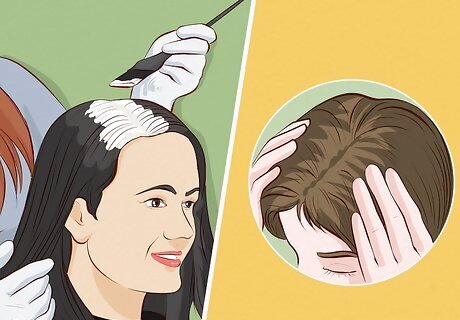
Take time to grow it out. Work with a professional stylist to gradually grow out your hair to your natural or desired color. It is a slower process but will cause the least damage to your hair overall. The con is that you'll have your natural color at the roots and your previously-colored hair on the ends. Your stylist may be able to give you some highlights to help blend your natural color with the dyed color at the ends of your hair.



















Comments
0 comment